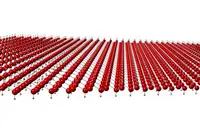 Germanium – used to create transistors in the early days of electronics – is being researched by a number of institutions as a potential replacement for silicon.
Germanium – used to create transistors in the early days of electronics – is being researched by a number of institutions as a potential replacement for silicon.
Germanium – used to create transistors in the early days of electronics – is being researched by a number of institutions as a potential replacement for silicon.
One such project is underway at Ohio State University, where assistant professor of chemistry Joshua Goldberger is working with germanane, a 2D variant of the element. He created a sheet of germanane one atom thick in 2013 and has since been creating hybrid versions of the material, incorporating atoms such as tin across the top and bottom of the sheet,
The goal, says Goldberger, is to make a material that not only transmits electrons 10 times faster than silicon, but which is also better at absorbing and emitting light.
"We've found that, by tuning the nature of these bonds, we can tune the electronic structure of the material," he said. "We can increase or decrease the energy it absorbs so, potentially, we could make a material that traverses the entire electromagnetic spectrum or which absorbs different colours."
Aside from traditional semiconductor applications, it has been predicted that a tin version of the material could conduct electricity with 100% efficiency at room temperature. The heavier tin atom allows the material to become a 2D topological insulator, which conducts electricity only at its edges. Such a material is predicted to occur only with specific bonds across the top and bottom surface, such as a hydroxide bond.
Goldberger's lab has verified that this theoretical material can be chemically stable and created germanane with up to 9% tin atoms. The group is now working on ways to produce pure tin 2D derivatives.
Meanwhile, as they create the various forms of germanane, the researchers are trying to exploit traditional silicon manufacturing methods.
Author
Graham Pitcher
Source: www.newelectronics.co.uk

